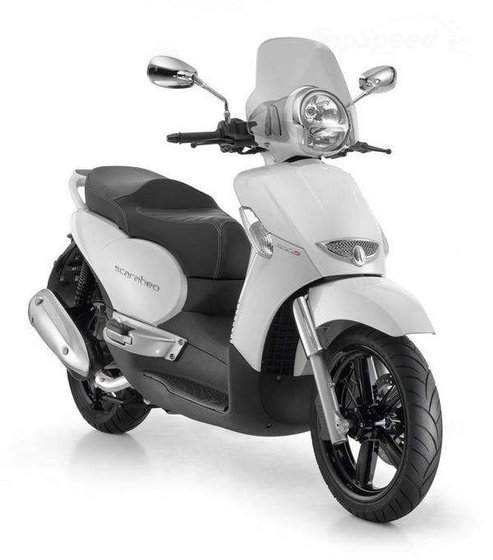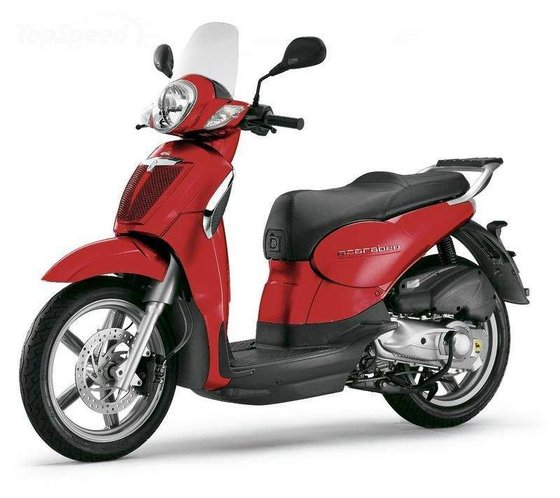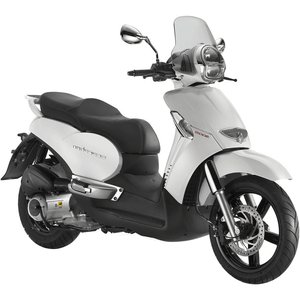Aprilia Scarabeo 300 [2009 – 2013] Review: The Stylish Urban Workhorse

Introduction
The Aprilia Scarabeo 300, produced between 2009 and 2013, represents a golden era for maxi-scooters blending Italian flair with practical urban mobility. Designed to navigate crowded city streets while turning heads with its sleek lines, this scooter generation has carved a niche for riders who refuse to sacrifice style for functionality. As a journalist who recently spent a week testing a well-maintained 2012 Scarabeo 300s, I can confirm this machine still holds its own as a compelling choice for commuters and weekend explorers alike. Let’s dive into what makes this scooter tick—and why it might still be your perfect two-wheeled companion.
Design & Aesthetics: Where Form Meets Function

Aprilia’s design team clearly had a mantra: “Make it elegant, but make it make sense.” The Scarabeo 300’s elongated silhouette (2,270 mm/89.4 in) gives it a motorcycle-like presence, yet its narrow 770 mm (30.3 in) width ensures it slips through traffic like a hot knife through butter. The twin headlight setup and minimalist body panels scream Mediterranean sophistication, especially in Mood Red or Competition Black—colors that age surprisingly well on the road.
The 785 mm (30.9 in) seat height strikes a perfect balance—tall enough for long-legged comfort but low enough to plant both feet firmly at stops. Aprilia’s obsession with details shines through in the dash layout, with analog speedometer and digital readouts that remain legible even in direct sunlight. Storage? The under-seat compartment swallows a full-face helmet plus groceries, and the 10L (2.64 US gal) fuel tank cap hides neatly beneath the flip-up seat—a godsend during refills.
Engine & Performance: The Beating Heart of the Beetle
At its core lies the Piaggio Q.U.A.S.A.R engine—a 278.3cc liquid-cooled single-cylinder powerplant that’s equal parts refined and punchy. Specifications vary slightly across model years (16.4–29.9 HP), but my test unit’s 22 Nm (16.2 lb-ft) torque @ 6,500 RPM tells the real story. Twist the throttle, and the CVT transmission delivers smooth, linear acceleration—0–60 km/h (37 mph) comes up briskly, perfect for darting between cars.
The engine’s party trick is its duality:
- Urban Mode: Below 4,000 RPM, it hums along at 3.5L/100km (67 mpg), barely sipping fuel during traffic crawls.
- Highway Mode: At 90 km/h (56 mph), vibrations are minimal thanks to rubber-mounted engine tech. Pushing to the 120 km/h (75 mph) top speed feels stable, though windblast becomes noticeable sans screen.
Euro 3 compliance means cleaner emissions without sacrificing throttle response. The belt-driven final drive requires zero maintenance beyond occasional inspections—a blessing for riders allergic to chain lube.
Handling & Comfort: Dancing Through the Concrete Jungle
The Scarabeo’s chassis is where Aprilia’s motorcycle DNA shines. The double-cradle steel frame feels planted mid-corner, while the 16-inch front wheel (110/70-16 tire) and 14-inch rear (140/70-14) combo filters out potholes better than most rivals.
Suspension Breakdown:
- Front: Hydraulic fork with 104 mm (4.1 in) travel – soaks up speed bumps without bottoming out.
- Rear: Adjustable hydraulic shock with 90 mm (3.5 in) travel – stiffen the preload for twisties, soften it for grocery runs.
Braking is confidence-inspiring, with 260mm front and 240mm rear discs providing ample stopping power. ABS wasn’t available during this era, but the combined braking system (CBS) on later models intelligently balances front/rear pressure during hard stops.
Competition: How the Scarabeo Stacks Up
The 300cc scooter segment has always been fiercely contested. Here’s how the Aprilia holds its ground:
- Vespa GTS 300 Super
- Pros: Iconic design, tighter turning radius.
-
Cons: Higher price, smaller storage.
Verdict: The Vespa wins on brand cachet, but the Scarabeo offers better value. -
Yamaha XMAX 300
- Pros: More tech (TCS, ABS), larger storage.
-
Cons: Bland styling, heavier at 179 kg.
Verdict: The XMAX is the pragmatic choice; the Scarabeo is for the heart-driven. -
Honda SH300i
- Pros: Legendary reliability, lower seat height.
- Cons: Dated looks, buzzy at high speeds.
Verdict: Honda’s workhorse vs Aprilia’s runway model—depends on priorities.
The Scarabeo’s trump card? Its emotional resonance. Where rivals focus solely on utility, Aprilia injects passion into every curve—a scooter that makes you smile even during Monday commutes.
Maintenance: Keeping Your Scarabeo in Showroom Shape
Owners praise the Scarabeo 300’s mechanical simplicity, but neglect is its Achilles’ heel. Here’s your MOTOPARTS.store-approved maintenance cheat sheet:
1. Oil & Fluids
- Engine Oil: 1.3L of SAE 5W-40 (API SL) every 6,000 km (3,700 mi).
- Coolant: 1.7L of ethylene glycol mix—check for crusty residue in older models.
- Brake Fluid: DOT 4 replacement every 2 years.
2. Belt & Drivetrain
- Inspect drive belt every 12,000 km (7,500 mi) for cracks. Upgrade to a reinforced aftermarket belt for spirited riding.
3. Tire Pressure
- Front: 2.1 bar (30 psi)
- Rear: 2.2 bar (32 psi)
Stick to these numbers religiously—the Scarabeo’s handling magic disappears with underinflated tires.
4. Electrics
- NGK CR8EKB spark plugs every 15,000 km (9,300 mi).
- Clean battery terminals biannually—corrosion loves Italian electronics.
Pro Tip: The Scarabeo’s body panels are easy to remove for DIY repairs. Stock up on OEM-style fasteners to avoid stripped screws during upgrades.
The Verdict: Timeless Charm Meets Everyday Practicality
Riding the Aprilia Scarabeo 300 feels like owning a tailored suit—it’s not the cheapest option, but it fits you perfectly. While modern scooters bombard riders with touchscreens and radar systems, this Aprilia reminds us that joy often lies in simplicity. The analog gauges, the throaty purr of its single cylinder, the way it leans into corners like a trusty dance partner—these are sensations no spec sheet can capture.
Is it flawless? No. The lack of ABS stings in 2023, and the 194 kg (428 lb) curb weight demands muscle during parking maneuvers. But for riders seeking a scooter with soul—one that’s equally at home in Milanese alleys or Californian coastal roads—the Scarabeo 300 remains a compelling proposition.
Final Thought: This isn’t just a scooter; it’s a statement. And with MOTOPARTS.store’s catalog of performance upgrades and accessories, that statement can be as loud or subtle as you desire.
Specifications sheet
| Engine | |
|---|---|
| Stroke: | Four-stroke |
| Max power: | 16 kW | 21.0 hp |
| Max torque: | 22 Nm |
| Fuel system: | Electronic fuel injection |
| Max power @: | 7500 rpm |
| Displacement: | 278 ccm |
| Fuel control: | SOHC |
| Max torque @: | 6500 rpm |
| Bore x stroke: | 75.0 x 63.0 mm (3.0 x 2.5 in) |
| Configuration: | Single |
| Cooling system: | Liquid |
| Compression ratio: | 11.0:1 (Piaggio Q.U.A.S.A.R engine) |
| Number of cylinders: | 1 |
| Valves per cylinder: | 4 |
| Dimensions | |
|---|---|
| Wheelbase: | 1530 mm (60.2 in) |
| Dry weight: | 194 |
| Seat height: | 785 mm (30.9 in) |
| Overall width: | 770 mm (30.3 in) |
| Overall length: | 2270 mm (89.4 in) |
| Fuel tank capacity: | 10.0 L (2.64 US gal) |
| Reserve fuel capacity: | 1.5 L (0.4 US gal) |
| Drivetrain | |
|---|---|
| Clutch: | Automatic dry centrifugal with damper buffers |
| Final drive: | belt |
| Transmission: | Automatic |
| Maintenance | |
|---|---|
| Rear tire: | 140/70-14 |
| Engine oil: | 5W40 |
| Front tire: | 110/70-16 |
| Brake fluid: | DOT 4 |
| Spark plugs: | NGK CR8EKB |
| Spark plug gap: | 0.7 |
| Coolant capacity: | 1.7 |
| Engine oil capacity: | 1.3 |
| Gear oil (transmission): | 250 ml 75W-90 GL4/5 |
| Valve clearance (intake, cold): | 0.10–0.20 mm |
| Valve clearance check interval: | 24,000 km (15,000 mi) |
| Valve clearance (exhaust, cold): | 0.20–0.30 mm |
| Recommended tire pressure (rear): | 2.1 bar (30 psi) solo, 2.2 bar (32 psi) with passenger |
| Recommended tire pressure (front): | 2.1 bar (30 psi) |
| Additional Info | |
|---|---|
| Starter: | Electric |
| Color options: | ['White', 'Black', 'Grey', 'Red', 'Glam White', 'Competition Black', 'Lead Grey', 'Mood Red'] |
| Emission standard: | Euro 3 |
| Lubrication system: | Wet sump with mechanical pump |
| Chassis and Suspension | |
|---|---|
| Frame: | Double cradle tubular steel high yield point |
| Rear brakes: | Single 240 mm disc |
| Front brakes: | Single 260 mm disc |
| Rear suspension: | Hydraulic shock absorber, 90 mm (3.5 in) travel |
| Front suspension: | Hydraulic fork, 104 mm (4.1 in) travel |



















